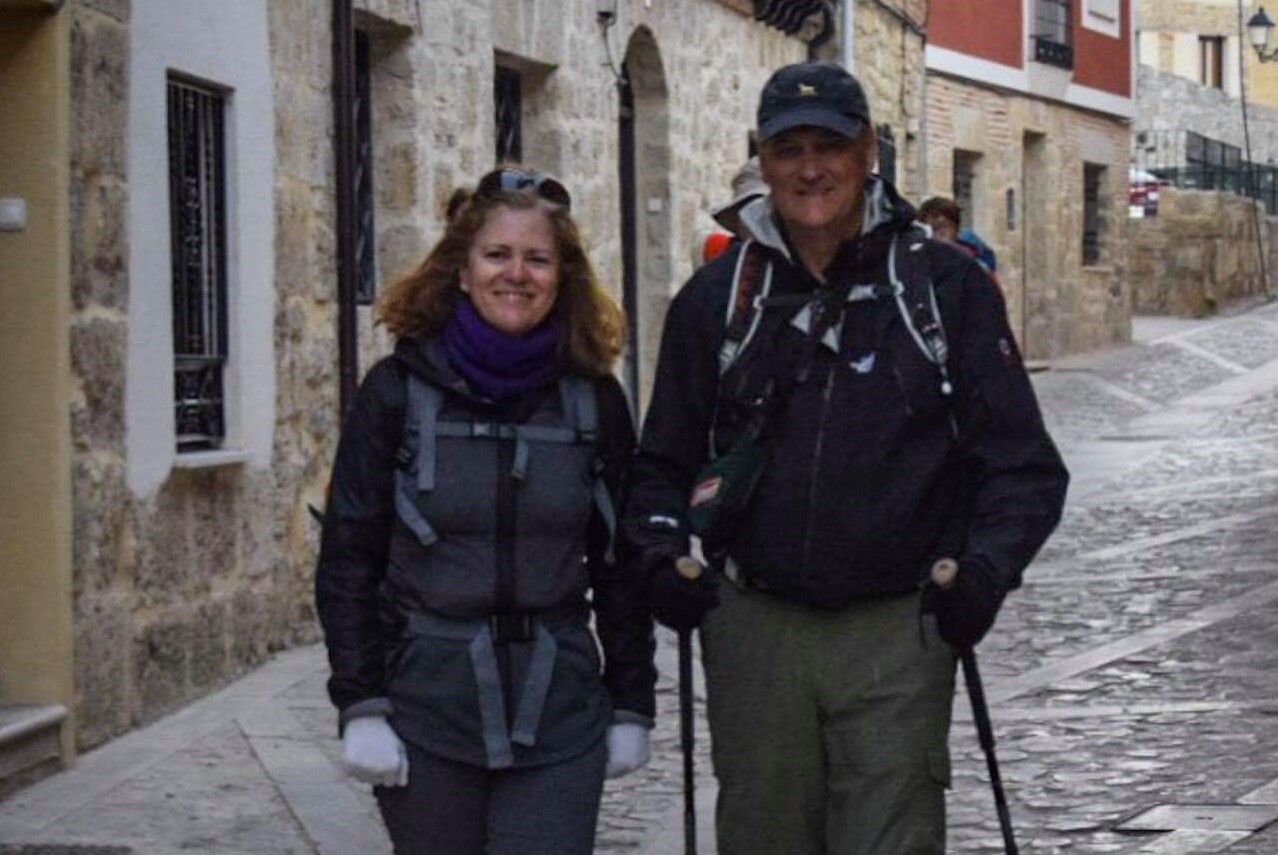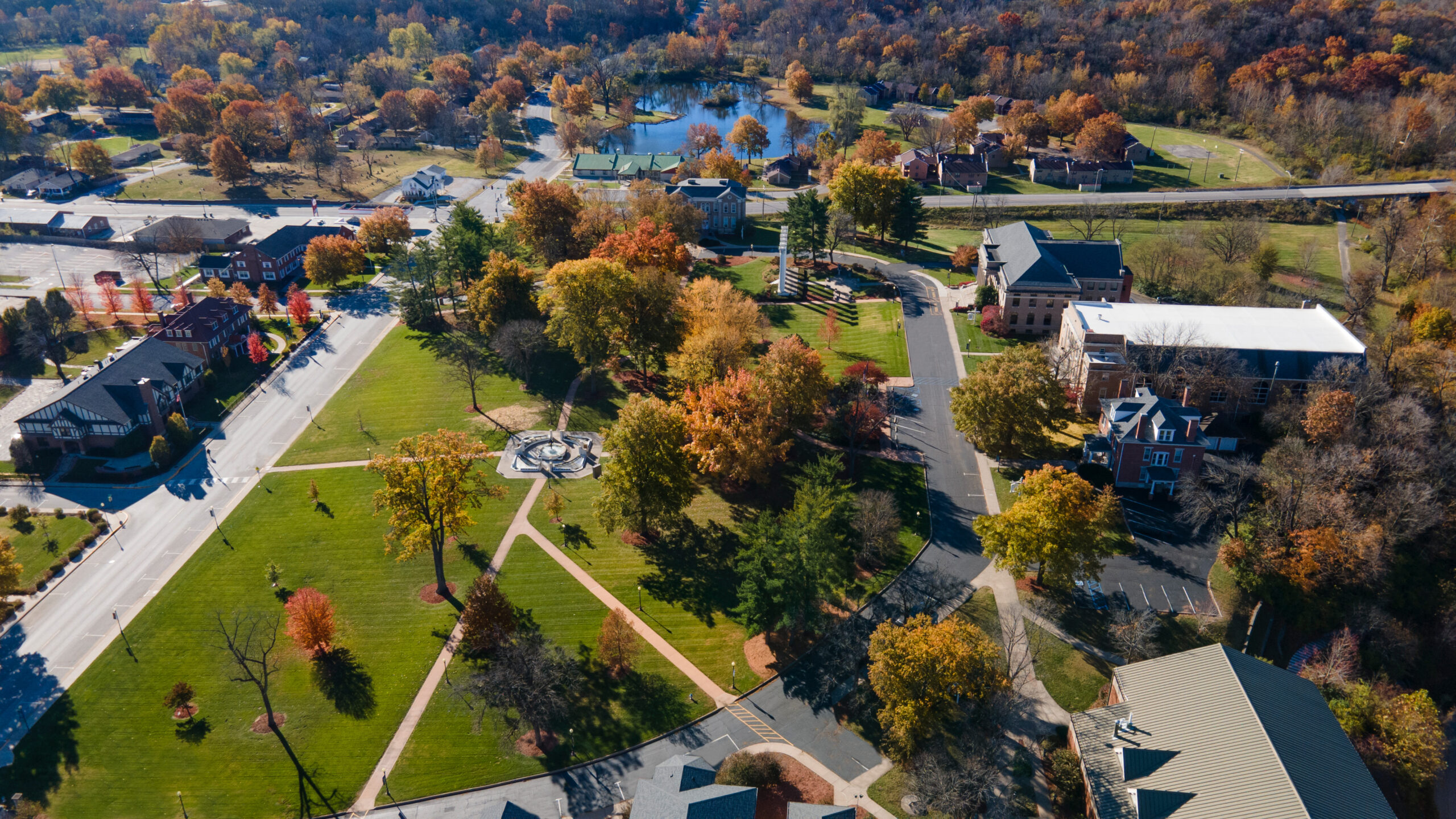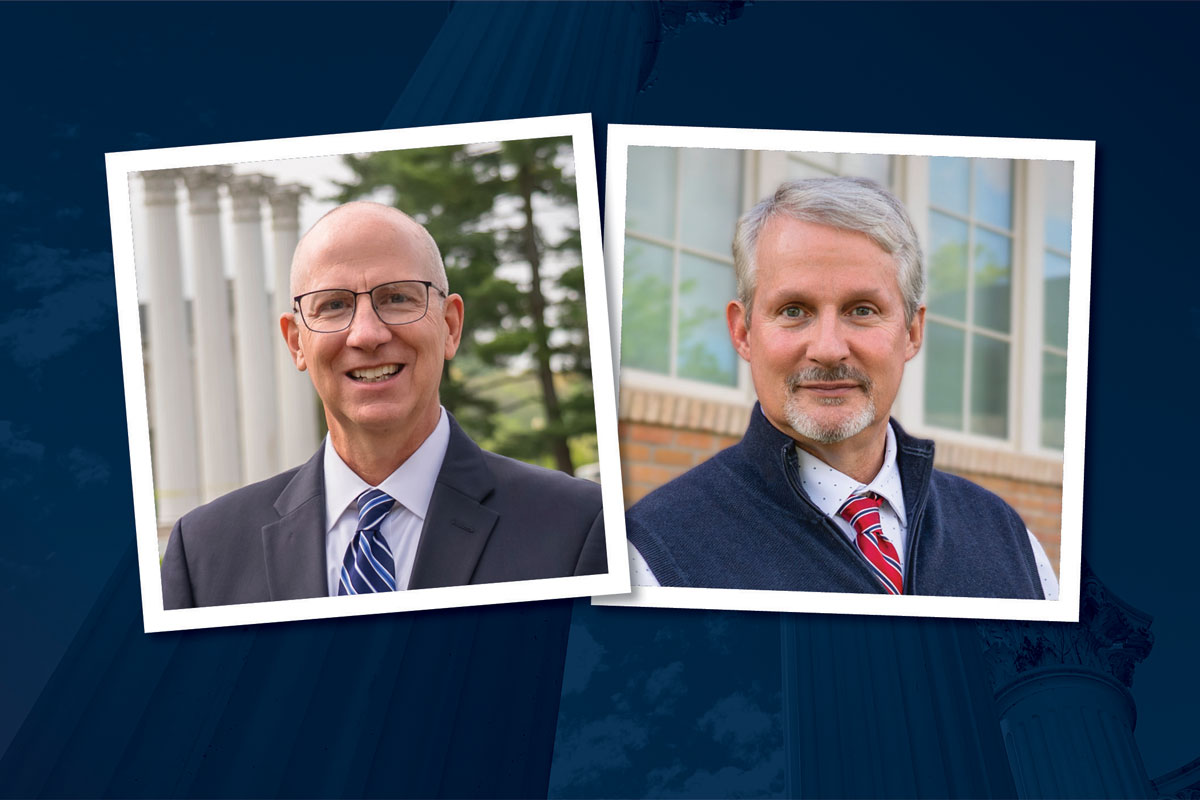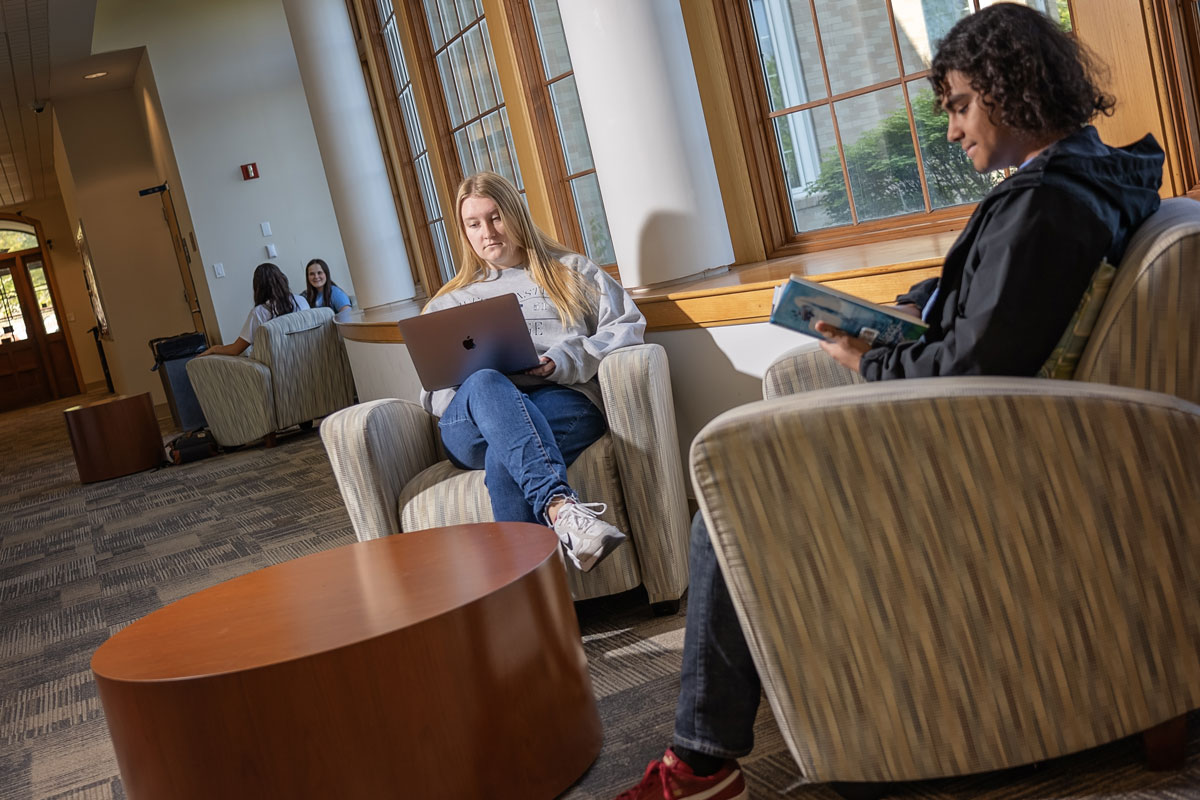The following travel journal originally appeared in Life @ the Dominion. The story by Jeff Leeka ’77 ΣΑΕ of San Antonio, TX, chronicles the 2017 pilgrimage he took with his wife, Joanne, from Saint-Jean-Pied-de-Port, France, to Cape Finisterre, Spain. Story published with permission by Leeka and Life @ the Dominion.
Learning to Walk With G.R.A.C.E.
Jesus said, “It’s better to serve than be served” (Mark 10:31). Walking the ancient trail of El Camino de Santiago de Compostela epitomizes serving others.
I’m Jeff Leeka and my wife, Joanne, and I have lived in The Dominion for 17 years. In April and May of this year we walked The Camino from France to the west coast of Spain. Saint-Jean-Pied-de-Port, France, to Cape Finisterre, Spain. It is also know as The Way of St. James, or The Way, and also El Camino de Santiago de Compostela. The distance was 490 miles. Tradition says the remains of the apostle James are buried in Santiago. We decided to follow the route to deepen our spiritual growth.
Our first day we crossed the Pyrenees Mountains. We met Ann from Ireland on the trail. She was about 56 years old and traveling alone. It was a difficult climb and hot that day. Ann ran out of water after about 6 hours. We were all extremely thirsty. We had about eight kilometers to go and Ann asked Joanne for some water. Joanne had about 2 inches of water left, and handed her the bottle. She drank about an inch and was very grateful. I was happy that Joanne cheerfully gave up her water, but I knew it was a difficult decision. When we finally got to the top, there was a picnic area and Ann sat down at the table and cried uncontrollably. The climb was difficult and it was a tough first day. Fortunately, from there it was about three kilometers to the albergue and it was all downhill. The act of ‘service’ is common on The Camino.

Carrión is a beautiful little town. Long walk to get here though. This little town was a wealthy and important Camino town with as many as 10,000 citizens in the Middle Ages and no less than 14 pilgrim hospitals. According to legend, Charlemagne camped here in his campaign against the Moors, who had succeeded in building a castle in Carrión in the 8th century. It is also the home to famous medieval poet Sem Tob, a Jewish rabbi known for his epic poem Proverbios Morales.
We started in France in a little town called St. Jean Pied-de-Port. After checking into The Camino Office and receiving our Camino Passports we headed to our first albergue. An albergue is a place designed for pilgrims to stay. Bunk beds are the norm, and a ‘pilgrim’s meal’ can be purchased additionally. For a bed and a meal the cost averages 15€ and you’re sharing the space with as many as 160 other pilgrims. Some albergues held as few as 20. They stamp your Camino Passport and you’re officially a Pellegrino, a pilgrim. Scallop shell markings and yellow arrows on the ground showing the way were found every few kilometers and sometimes more frequently. You don’t want to miss a sign because it means more walking!

Joanne and I both know that walking The Camino is once in a lifetime experience. We met people and heard languages from every country in the world. Not to our surprise we found people are similar all over the world. Some are searching for something, some are dealing with serious life problems, and others are quite carefree and simply living in the moment. In attempting to walk with ‘grace,’ and to more deeply embrace this teaching, we summarized what we discovered in this acrostic:
Go. Jesus said, “Go into all the world and preach the gospel to all creation” (Mark 16:15). My attention span is short, so I’ve always been better at the “go” portion, which is what we did. Don’t delay, do it immediately, plan, prepare, make sure it’s safe, reasonable and within your budget…but GO! The hardest part is the first step. And with all the ‘going,’ we tried to practice ‘giving.’ We wanted to work on being present in each moment, listening to each person, and empathizing with their story. We knew each person’s life-story, their Camino, is different, each experience, each challenge, and each defeat. We heard over 100 stories. Some stories made us laugh, some cry, and some left us with a smile.

This Spaniard was sitting in the shade near Rabanal Del Camino. He spoke no English, and with our broken Spanish we determined he said he was a descendant of a soldier of Charlemagne. He loved this falcon and let me hold it. Charlemagne (c.742-814) was a medieval emperor who ruled much of Western Europe from 768 to 814. In 771, Charlemagne became king of the Franks, a Germanic tribe in present-day Belgium, France, Luxembourg, the Netherlands and western Germany. He embarked on a mission to unite all Germanic peoples into one kingdom, and convert his subjects to Christianity. He strove to ensured the survival of Christianity in the West. Today, Charlemagne is referred to by some as the father of Europe.
Rigor. Life can be very difficult, and certainly on The Camino. We experienced rain, cold, snow, sleet, hail, as well as hot temperatures. The Pyrenees Mountains erupt from the earth like a rocket from a launch pad. Slow going, treacherous, and difficult.
Everyday we got up and started walking. We didn’t always feel like it, our feet hurt, our muscles ached, and we pressed on. A typical day began before 7 a.m. and we enjoyed the sunrise. Some mornings weren’t too cold, maybe 45 degrees, while others were less than 32 degrees. After two hours, we typically took a break and rested for 20 minutes. We let our feet dry, changed our socks, and attended to our blisters. Typically, we stopped walking between 2 and 4pm. We’d then checked into an albergue, showered, hand-washed our clothes, hung them up to dry, and then looked for dinner somewhere. Most commonly we ate a pilgrim’s meal. Not a large amount of food, certainly less than we typically eat, but tasty. Each time we ate, we ate every bite and felt every very grateful to be full.
Appreciate. The Pellegrino’s meal is simple, but good, and certainly filling. There were plenty of opportunities for wonderful restaurant-style meals, but we usually ordered the Pellegrino meal. Generally, a Spanish breakfast is light, with the bigger meal around noon and a light meal at night. The light meals were a reminder of people who have very little, but yet are still very happy. Perhaps they’re happy because they appreciate life and whatever comes their way, both negative and positive. They use the negative experiences as a learning event and bask in the warmth of the positive. We walked past over 350 churches, all beautiful, and most very, very old. At our church, we recently went through a large expansion so it’s big and new and beautiful. We both returned with a renewed appreciation for our church and all the time, work, money, and prayers that went into its completion.

There’s an old pilgrim legend about this place. El Fuente Reniega (Fount of Renunciation) is here, where a pilgrim was extremely thirsty. The devil came to him in the form of a wanderer and offered to give him water if he would just renounce God. The pilgrim stayed strong in the faith and refused. Having passed the test the devil disappeared and Santiago (St. James) appeared to the pilgrim and offered him water to drink from a scallop shell. Thus, the shell pilgrims wear on their packs. The statue in the background is of medieval pilgrims and the size of it is about 40 meters long. Quite a hike to the top of this mountain. We were thirsty!
Carry. Lightweight is the word of the day. On The Camino you have only what you can carry, so it’s not that much. We paid close attention to every single item we carried. Each person walks on the own, carries their own backpacks, take their own steps, walk through their own problems, and they go their own distance. The apostle Paul said that he could do all things through Christ who strengthened him (Philippians 4:13). Paul looked to God to enable him to do everything, and he encourages us to do the same. It occurred to us that we need to stop carrying those things which are too heavy and we’re not meant to carry. We broke our toothbrushes in half, ditched extra pairs of socks, and gave our sleeping bags away. After three days I gave my old, heavy, backpack away and bought a new, lightweight bag. It made us think that we need to eliminate even the small things that separate us from our goals. We ran into many people who were carrying things that they obviously shouldn’t carry. They spoke about these things too, knowing that they should be dropped. Examples of things that were too heavy that were heard about were: infidelity, alcohol abuse, drug abuse, family issues, pornography, and the list went on-and-on. None of us are meant to carry such things.
 From the very top of Castrojeriz. (Castrojeriz, Spain).
From the very top of Castrojeriz. (Castrojeriz, Spain).
Encouragement. ‘Buén Camino’ is the expression other Pellegrinos and locals on The Camino said to encourage one another. We have come to appreciate this greeting even more from the locals. Within this little phrase there is a greeting, a well wish, and an acknowledgement that you were sharing The Camino. Buén Camino’ can also be a prayer. A prayer that the day be blessed with many graces, that you might arrive safely at the destination, and that it would be an enjoyable walk. The ultimate desire is that The Camino of life might go well, meaning you would come to know, love and serve Jesus Christ who is ‘The Way.’ This discipleship is a deep desire we have and pray it is for each pilgrim we meet on the road of life. It also reminded us of Jesus’ remark to Pilot. When Jesus was on trial and stood before Pilot he said, “I came into the world for this: to testify to the truth. Everyone who is committed to the truth listens to my voice.” Jesus made this clearer still when He said, “I am the vine; you are the branches. Whoever abides in me and I in him, he it is that bears much fruit, for apart from me you can do nothing” (John 15:5). No matter what trials strike us in life, if we turn to the truth, then strength, wisdom, and way to endure them will be provided. It’s a great promise…and encouraging.

We stayed in Terradillos de los Templarios. The Knights Templar where a medieval military order responsible for protecting pilgrims. The order was popular and successful for almost 200 years, however grand master Jacques de Molay was arrested in 1307 (on Friday the 13th, possibly the origin of the superstitious date) and burned at the stake for heresy in a variety of trumped-up charges. The order was then disbanded.
When the subject of faith comes up on the Camino, most people are guarded. Perhaps people are guarded everywhere. Seems like they’ve been hurt by injustice, misunderstanding, and tough judgment. We’re all looking for an understanding ear and a kind voice. By meeting many, many folks from every culture and country in the world, we more clearly realize that we’re all different. We think differently, act differently, have different circumstances, life experiences and outlooks. We know we don’t deserve GRACE ourselves, but having experienced it firsthand, and having received it, we know it’s something we can share with others. Our Camino walk helped prioritize this concept.

We arrived in León in time to see the Easter processionals. León begin as a Roman military encampment in 29 BC and developed into a permanent settlement charged with protecting Galatians’ gold on the journey to Rome. León was loud this week. Holy Week is the annual tribute celebrated by Catholic religious brotherhoods that perform penance processions on the streets. Hundreds of pigeons were released. It’s considered good luck to get hit with the droppings of one…we received no such luck.
The other thing we learned: when you start a sentence with, “Jesus said,” people stop what they’re doing and listen, even unbelievers. Here’s an example: its 9pm, almost dark, the albergue has 60 bunk beds, people are drifting off to sleep. Everyone is very tired, and the room is silent. I said, “Jesus said.” 30 seconds…45 seconds…60 seconds pass, and a young Spaniard, Rafael, several beds away, said in very broken English, “what did he say?” Rafael looked to be someone with lots of trouble; perhaps drug or alcohol addiction; a young man who had led a rough life. I said, “Jesus said, God wants to bless you…but you have to ask” (Luke 11:9). Again…30 seconds…45 seconds…60 seconds, and Rafael said, in broken English, “I’m asking.” I guess I replied with what each of us would say, which was, “he’s listening.”

Astorga was first a Celtic settlement and then developed into an important Roman city. According to legend, both St James and St Paul preached here. The city passed to the Visigoths in the 5th-century, was destroyed by the Muslims in 714, then in mid 19th-century reconquered by Ordoño l. The 15th-century Astorga Cathedral features an impressive Baroque façade. We toured the Museo del Chocolate (Chocolate Museum) after arriving. It documented the chocolate industry back to the 18th-century.

We’ve now entered Galicia, the last of the autonomous regions on The Camino. We walked up to 4,500 feet. Excavations have shown evidence of megalithic prehistoric cultures. Galatians are Celts and known for being fiercely independent (Braveheart) and resistant to foreign rule. Glacia is known as ‘o pais dos mil rios’, the country of a thousand rivers. Breathtaking views at the top of the mountain, we’re in O Cebreiro tonight. This city is known for being the birthplace of Father Elias Valiña Sampedro, a local priest who was instrumental in the 20th-century revival of The Camino de Santiago. He is said to have come up with the yellow arrow symbol which marks The Way and is also responsible for the cement markers in Galatia.
https://en.m.wikipedia.org/wiki/Camino_de_Santiago
Hot 2 days ago. Rainy and cold yesterday. Snowed on us today; very cold. Walked 24k today. In Palas de Rei. The town name comes from a legend that purports that the Visigoth King Witiza, and Arian heretic, constructed a palace here. The town is mentioned in the Codex Calixtinus (Compostellus); it’s the main witness for the 12th-century Book of Saint James. It is a pseudepigraph attributed to Pope Callixtus II. Its most likely date of compilation is 1138. It was intended as an anthology of background detail and advice for pilgrims following The Way of St. James. The collection includes sermons, reports of miracles and liturgical texts associated with Saint James.

We went through an interesting town, Melide, a couple days ago. It is well known for Pulpo á la Gallega, boiled octopus served with olive oil, paprika, and a hunk of bread in a ceramic bowl. Melide is not on the coast yet this is their claim to fame.


800 kilometers, which is 500 miles, which equals 1,049,868 steps. It’s taken a little over a month. Our feet are tired, our muscles are sore, our minds are clear and we’ve had a blast. We have arrived in Santiago de Compostela! Overwhelmed with emotion. Our Pilgrim Passports have recorded the “final stamp.” We going to sit down for a while.


Made it to the “End of the World.” Cape Finisterre is a rock-bound peninsula on the west coast of Galicia, Spain. Celebrated with a fish dinner! In Roman times it was believed to be the end of the known world. The name Finisterre (Finistère in France), derives from the Latin finis terrae, meaning “end of the earth”. Monte Facho is the name of the mountain on Cape Finisterre, which is where we are standing, at 781 ft above sea level. A prominent lighthouse is at the top of Monte Facho. The Artabri were an ancient Gallaecian Celtic tribe that once inhabited the area.
The Way by Jacks Blue
May 2017
To walk my path is yet to say,
It’s mine alone, it is my Way,
Each step I take I consecrate,
My choices, one and all I make.
Then look behind what I may see,
An empty path, how can that be?
Was I not there, not been that long,
Never again, that path now gone.
Sarah Rummel Backer is the Director of Media Relations and Senior Writer at Westminster College in Fulton, Missouri. A proud Westminster graduate, Sarah has more than 20 years of experience in marketing and strategic communications in the areas of higher education, medicine, agriculture, and the private business sector.







You must be logged in to post a comment.